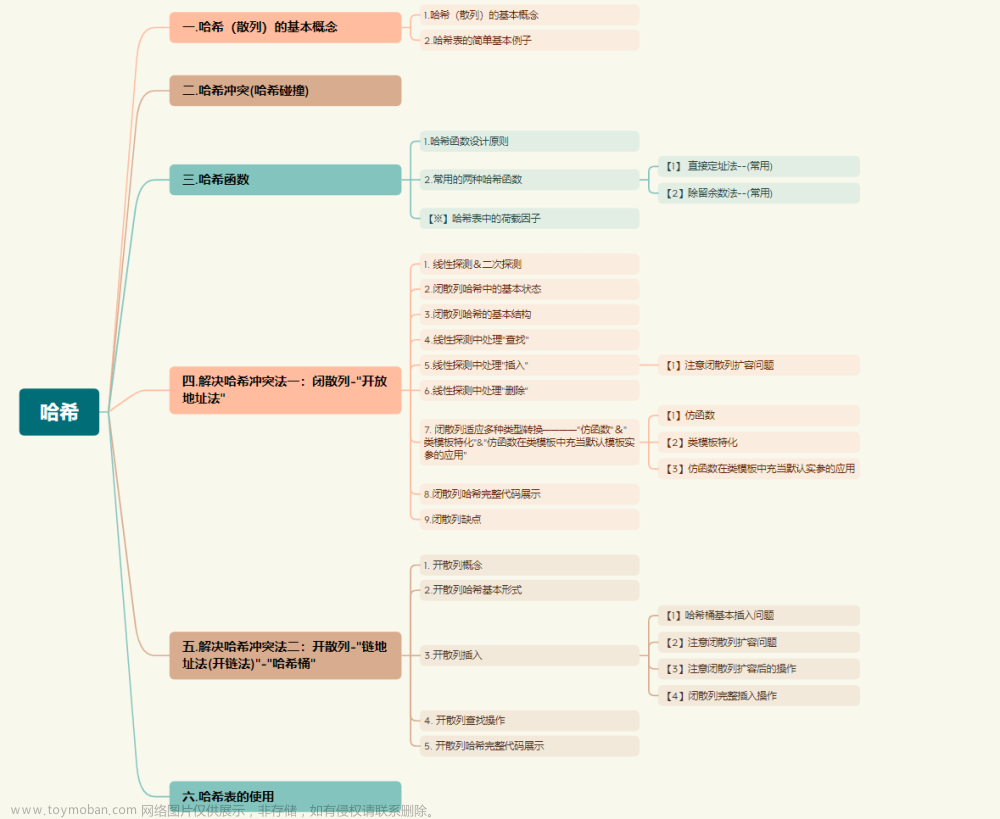C++语法(21)---- 模拟map和set_哈里沃克的博客-CSDN博客https://blog.csdn.net/m0_63488627/article/details/130354019?spm=1001.2014.3001.5501
目录
1.哈希表的介绍
1.stl中的哈希表使用
2.比较
3.哈希的原理
4.哈希映射的方法
1.直接定址法
2.除留余数法
5.解决哈希冲突
1.闭散列
2.开散列(哈希桶)
1.哈希表的介绍
1.stl中的哈希表使用
unordered_map(K,V)
unordered_set(K)
hash<KEY>其实是一个仿函数,是因为数据要和位置映射,那必然要取余,string等类无法使用取余,那么需要我们自己写一个进行判断。
2.比较
其上层的使用与map以及set及其的相近。但是又有什么不同呢
1.大量随机数据插入,map和set性能快
2.查找数据,哈希表级制性能,时间复杂度为O(1)
3.大量随机数据删除,也是map和set性能快
3.哈希的原理
就是将数据和存储位置做一个映射,这个映射就是哈希映射。所以使用哈希表的好处就是找到自己想要的数据时间复杂度很低
4.哈希映射的方法
1.直接定址法
取关键字的某个线性函数为散列地址:Hash(Key)= A*Key + B -- 某个值都要唯一的位置
优点:简单、均匀
缺点:需要事先知道关键字的分布情况,如果数据比较分散开辟空间会很浪费
使用场景:适合查找比较小且连续的情况2.除留余数法
设散列表中允许的地址数为m,取一个不大于m,但最接近或者等于m的质数p作为除数,
按照哈希函数:Hash(key) = key% p(p<=m),将关键码转换成哈希地址 -- 几个值都可能在同一个位置优点:空间适合
缺点:这种情况,会存在可能多个值取余后得到相同的映射地址(哈希冲突)使用场景:适合分散的场景
5.解决哈希冲突
1.闭散列
实现原理:冲突位置,那么往后判断是否是否为空
缺点:查找效率变低,互相冲突导致插入逻辑复杂
1.线性探测(一个萝卜一个坑,坑被占了线性往后找下一个空的) --- start+i
2.二次探测,是以平方为步调向后判断的 --- start+i^2
线性探测实现:
表内元素的状态
冲突主要是因为一个数已经存在于表中,那么才需要往后判断是否为空,所以已经知道需要两个状态:存在和空。不过如果我们要往后搜索,如果只有两个结果,那么在连续冲突的数中删除,那么数据就中断了,那么实现就会出现错误,那么此时还需要一个状态表示:删除。
enum State { EMPTY, EXIST, DELETE, };元素属性定义
此外为了保持和map的一致性,我们的节点元素也要使用pair与之对应,并且伴随节点的状态,节点先处理为empty,说明数组中的状态为空
template<class K, class V> struct HashData { pair<K, V> _kv; State _state = EMPTY;; };表的框架
当然,对于一个模板,并不知道比较大小是通过什么方式比较的,所以我们还得添加上仿函数进行比较。
template<class K> struct HashFunc { size_t operator()(const K& k) { return (size_t)k; } }; //特化了一个string的仿函数,它的大小比较按照我想要的方式实现 template<> struct HashFunc<string> { size_t operator()(const string& k) { size_t hash = 0; for (auto& ch : k) { hash += ch; } return hash; } };template<class K, class V, class Hash = HashFunc<K>> class HashTable { typedef HashData<K, V> Data; public: HashTable() { _tables.resize(10); } private: vector<Data> _tables; //存储数据的空间 size_t _n = 0; //进去的数有多少 };insert
关于capacity和size问题,首先我们插入的位置一定的在size内,因为如果是判断capacity,那么值的映射可能会在capacity和size之间,但是size只有那么大,所以找不到映射后的位置也有可能,所以判断靠判断和size的大小的。不过我们可以设计成size和capacity一样大,这样就不会出现这种尴尬。capacity和size一致,我们使用resize()函数就能解决。
实现逻辑就是:当判断映射位置为存在,那么我们就需要往后找,不过不能超过整体范围,所以我们需要对hashi进行取余处理。随后找到位置则插入,状态设置为EXIST,将_n加一。
Hash hf; //仿函数 size_t hashi = hf(kv.first) % _tables.size(); //线性探测 while (_tables[hashi]._state == EXIST) { hashi++; hashi %= _tables.size(); } _tables[hashi]._kv = kv; _n++; _tables[hashi]._state = EXIST; return true;出现了有些问题:
问题:表的数据存储满了,那就有扩容问题 --- 此外,暂且不说存储满了,如果数据很多都被覆盖了,那么此时再想插入是不是也就意味着非常容易冲突呢?此时插入成本就很高了
结论:所以我们不能让它满,我们需要添加一个负载因子,使得我们在表中出现百分之几十后说明我们需要扩容。负载因子越小,说明固定空间中的数据越少,那么使得冲突的几率就小。不过太小浪费空间,太大浪费时间,所以设计的负载因子一般为0.7。
实现:
1.此时我们要注意,不能直接跟size比较是否小于0.7,因为int类型不能这样比较,所以我们要对_n*10随后比较是否小于7。
2.扩容不能直接把vector变大就好,因为里面的数据可能会对不上之后扩容的映射地址。所以我们新建一个表,再将原来的值依次insert进新表中,在把两表互换,新表出insert函数就被自动析构了。
3.此外map设置就不能出现两个相同的值,所以我们还会实现一个find函数,通过find函数找是否已经存在,如果存在则插入失败。
bool Insert(const pair<K, V>& kv) { if (Find(kv.first) != nullptr) return false; if (_n * 10 / _tables.size() >= 7) { HashTable<K, V, Hash> tmp; tmp._tables.resize(2 * _tables.size()); for (auto& e : _tables) { if (e._state == EXIST) { //复用了自己写的insert函数 tmp.Insert(e._kv); } } _tables.swap(tmp._tables); } Hash hf; size_t hashi = hf(kv.first) % _tables.size(); //线性探测 while (_tables[hashi]._state == EXIST) { hashi++; hashi %= _tables.size(); } _tables[hashi]._kv = kv; _n++; _tables[hashi]._state = EXIST; return true; }erase
先find(后面实现)想要删除的值,随后把插入的值的状态设置为DELETE即可,_n减一
bool Ereas(const K& k) { Data* cur = Find(k.first); if (cur == nullptr) return false; cur->_state = DELETE; --_n; return true; }find
找对应的位置,查看是否是我们想要的值,是则返回,不是则需要往下判断,直到走到空,说明找不到,则返回nullptr。
Data* Find(const K& k) { Hash hf; size_t hashi = hf(k) % _tables.size(); while (_tables[hashi]._state!=EMPTY) { if (_tables[hashi]._state == EXIST && _tables[hashi]._kv.first == k) return &_tables[hashi]; ++hashi; hashi %= _tables.size(); } return nullptr; }整体实现
namespace closehash { enum State { EMPTY, EXIST, DELETE, }; template<class K> struct HashFunc { size_t operator()(const K& k) { return (size_t)k; } }; /*struct HashFuncString { size_t operator()(const string& k) { return k[0]; } };*/ template<> struct HashFunc<string> { size_t operator()(const string& k) { size_t hash = 0; for (auto& ch : k) { hash += ch; } return hash; } }; template<class K, class V> struct HashData { pair<K, V> _kv; State _state = EMPTY; }; template<class K, class V, class Hash = HashFunc<K>> class HashTable { typedef HashData<K, V> Data; public: HashTable() { _tables.resize(10); } bool Insert(const pair<K, V>& kv) { if (Find(kv.first) != nullptr) return false; if (_n * 10 / _tables.size() >= 7) { HashTable<K, V, Hash> tmp; tmp._tables.resize(2 * _tables.size()); for (auto& e : _tables) { if (e._state == EXIST) { tmp.Insert(e._kv); } } _tables.swap(tmp._tables); } Hash hf; size_t hashi = hf(kv.first) % _tables.size(); //线性探测 while (_tables[hashi]._state == EXIST) { hashi++; hashi %= _tables.size(); } _tables[hashi]._kv = kv; _n++; _tables[hashi]._state = EXIST; return true; } Data* Find(const K& k) { Hash hf; size_t hashi = hf(k) % _tables.size(); while (_tables[hashi]._state!=EMPTY) { if (_tables[hashi]._state == EXIST && _tables[hashi]._kv.first == k) return &_tables[hashi]; ++hashi; hashi %= _tables.size(); } return nullptr; } bool Ereas(const K& k) { Data* cur = Find(k.first); if (cur == nullptr) return false; cur->_state = DELETE; --_n; return true; } private: vector<Data> _tables; //存储数据的空间 size_t _n = 0; //进去的数有多少 }; }
2.开散列(哈希桶)
实现原理:冲突位置,将对应位置加一个链表,冲突就挂到链表上(这也是stl不实现双向迭代器的理由)
缺点:链表太长会出现问题
优点:冲突间不会相互影响
哈希桶的实现
节点元素
其实就是所谓的链表节点
template<class K, class V> struct HashNode { pair<K, V> _kv; HashNode<K, V>* _next; };哈希表框架
向量中存储链表节点地址,冲突的节点被挂起即可
template<class K, class V, class Hash = HashFunc<K>> class HashTable { typedef HashNode<K, V> Node; private: vector<Node*> _table; size_t _n = 0; };insert
插入的逻辑其实就是:如果找到了地址,新节点的next指向表的下一个,表里填入新节点地址
size_t hashi = Hash()(kv.first) % _n; Node* newnode = new Node(kv); newnode->_next = _table[hashi]; _table[hashi] = newnode; _n++;因为如果不扩容,可能一个链表会很长一串,那么查找的效率就低了,那么我们规定负载因子一般取1.0;同样如果有重复的值,那么不需要插入,直接返回false;扩容的思想和上面基本一致,这里不多赘诉。
bool Insert(const pair<K, V> kv) { if (Find(kv.first) != nullptr) return false; if (_n == _table.size()) { HashTable<K, V, Hash> tmp; tmp._table.resize(2 * _table.size(),nullptr); for (auto cur : _table) { while (cur) { tmp.Insert(cur->_kv); cur = cur->_next; } } _table.swap(tmp._table); } size_t hashi = Hash()(kv.first) % _table.size(); Node* newnode = new Node(kv); newnode->_next = _table[hashi]; _table[hashi] = newnode; _n++; return true; }关于释放空间,对于闭散列,其实不需要手动释放,因为析构函数直接释放vector结构。不过我们现在的vector中存放的是节点,这些节点是需要被释放。
~HashTable() { for (int i = 0; i < _table.size(); i++) { Node* cur = _table[i]; while (cur) { Node* next = cur->_next; delete cur; cur = next; } _table[i] = nullptr; } }这样的设计其实瑕疵很大,因为我们不仅插入实现要创造新节点,而且扩容时也创建了新节点,析构也是依次释放节点。时间效率低。我们是否可以直接将原有节点转到新表中呢?
我们只需要开辟一个新的vector,随后将原先表中的值依次遍历的存到新表中,最后交换一下表的地址,这样就能达到节省拷贝时间和析构时间的目的了。
bool Insert(const pair<K, V> kv) { if (Find(kv.first) != nullptr) return false; if (_n == _table.size()) { vector<Node*> newTable; newTable.resize(2 * _table.size(),nullptr); for (int i = 0; i < _table.size(); i++) { Node* cur = _table[i]; while (cur) { Node* next = cur->_next; size_t hashi = Hash()(cur->_kv.first) % newTable.size(); cur->_next = newTable[hashi]; newTable[hashi] = cur; cur = next; } _table[i] = nullptr; } _table.swap(newTable); } size_t hashi = Hash()(kv.first) % _table.size(); Node* newnode = new Node(kv); newnode->_next = _table[hashi]; _table[hashi] = newnode; _n++; return true; }find
Node* Find(const K& k) { size_t hashi = Hash()(k) % _table.size(); Node* cur = _table[hashi]; while (cur) { if (cur->_kv.first == k) return cur; else cur = cur->_next; } return nullptr; }Erase
删除链表节点有些时候需要前驱,所以不能复用find函数文章来源:https://www.toymoban.com/news/detail-430465.html
bool Erase(const K& k) { size_t hashi = Hash()(k) % _table.size(); Node* cur = _table[hashi]; Node* prev = nullptr; while (cur) { if (cur->_kv.first == k) { if (cur == _table[hashi]) _table[hashi] = cur->_next; else prev->_next = cur->_next; delete cur; _n--; return true; } prev = cur; cur = cur->_next; } return false; }
保持表的大小为素数,这样表的冲突会减少。所以stl中会有存储素数的表,扩容的大小就按照该表中的值进行扩容。文章来源地址https://www.toymoban.com/news/detail-430465.html
到了这里,关于C++语法(22)---- 哈希表的闭散列和开散列的文章就介绍完了。如果您还想了解更多内容,请在右上角搜索TOY模板网以前的文章或继续浏览下面的相关文章,希望大家以后多多支持TOY模板网!




![【C++入门到精通】 哈希结构 | 哈希冲突 | 哈希函数 | 闭散列 | 开散列 [ C++入门 ]](https://imgs.yssmx.com/Uploads/2024/02/713477-1.jpeg)











